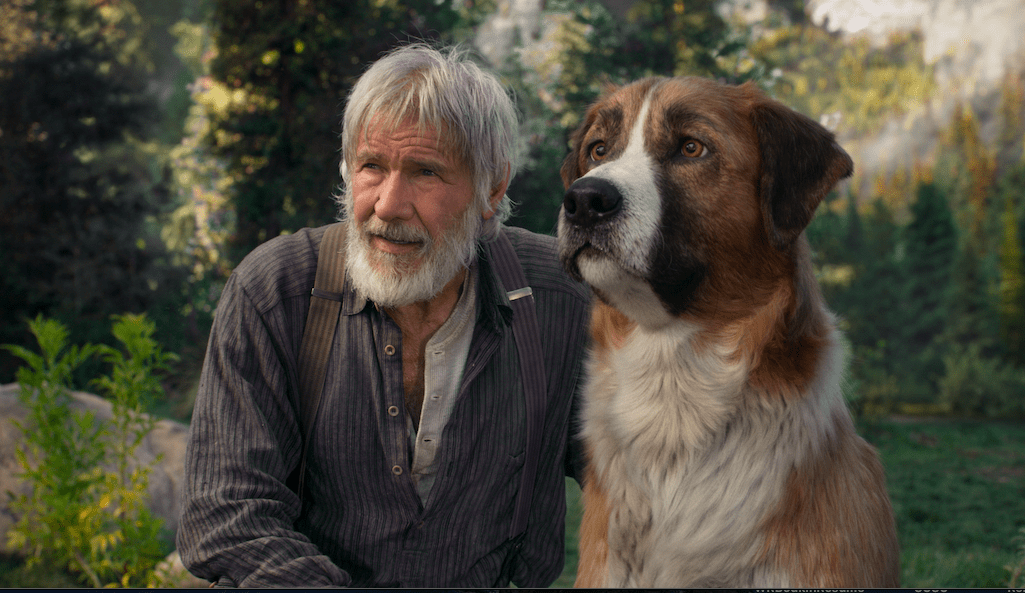
The main talking point that came from the first trailer for 20th Century’s adaptation of Jack London’s The Call of the Wild was — why is that dog not real? It was soon discovered that none of the animals in the film were real and the discussion about the film became more about why were all the animals were CGI animals rather that the film itself.
However, outside of the CGI, the trailers hinted at a slight sense of adventure and a rare Harrison Ford performance outside of a major franchise. My hopes were that this would be something that could minimize the CGI talk. Unfortunately, The Call of the Wild is a call that isn’t worth answering as it lacks the maturity and adventurous spirit to be anything more than just another “cute dog” movie.
The film follows Buck, a slightly spoiled dog living in comfort Santa Clara until he’s taken away and sold to work as a sled dog in the wilds of the Yukon. He goes through an incredible adventure with Perrault (Omar Sy), a Canadian dispatcher, and his sled dog crew. This eventually leads him to meet John Thorton (Ford), an experienced outdoorsman who’s isolated himself from the rest of the world. The two develop a bond and Thorton decides to bring Buck along on a journey that his deceased son couldn’t complete. Together, they embark on an adventure that brings them closer to the environment around them and find new personal meanings.
Now, because it’s a big part of The Call of the Wild’s issues, let’s just get to the review’s big rant about the egregious amount of CGI out the way. What the hell were they thinking? With so many films showing how effective having real animals on-screen can be for viewers to connect to the story, it’s hard to imagine why the choice of having CGI animals seemed like the right idea. Maybe the production thought that animals couldn’t be trained to do what Buck and other animals do in the film? Maybe it was director Chris Sanders’ background in animated films that inspired them to take the CGI route? Or, maybe it was just cheaper? While I have a sneaky suspicion that the last option was likely the main reason, there’s no reason to excuse the cartoony CGI. Nor is their a reason to excuse the weak script that creates more generic, family-friendly moments that are inauthentic to the novel.
With only some knowledge of the novel, my hope was that this adaptation could treat its characters with a similar maturity as the novel and possibly draw inspiration from animated films like Balto — especially with Sanders’ animation background. However, the only thing this film seems to want to be inspired by is other “cute dog” movie. It slowly strips away the realism and themes about returning to primitive nature found in the book; until the only thing that keeps your attention is when Buck does something that makes you go “aww.”
Through the cheesy animated reactions and actions, Buck’s “power” and “will” barely come to light past the film’s failed attempts at unoriginal humor. For instance, after Buck underwhelmingly defeats Spitz, the villainous leader of Perrault’s sled dog pack, Buck’s given the opportunity to triumphantly prove himself to be a strong leader. However, the film doesn’t give this moment any weight and is more pre-occupied with creating generically humorous moments of Perrault being annoyed by Buck and comically trying to push him to the back of the pack.
It’s even more upsetting to see how the overuse of CGI and family-friendly changes to the story really strays from London’s vision. The environments and animal designs look incredibly fake so there’s very little immersive realism and the journey Buck goes through in answering the “call of the wild” only scratches the surface in him rediscovering his primitive roots. London’s original novel is a strongly mature telling that evoke a harsh and at times gruesome return to roots. Now, this isn’t to say that you can’t adapt and change certain aspects of this story to appeal to a young audience, but this adaptation takes so much away that the primitive aspects of Buck’s journey that they barely resonate.
Things don’t even fare much better for the human cast as they either have one-note personalities or are just completely forgettable. Sy and Ford put in decent performances that attempt to uplift and add more human emotions to the story. With Sy’s Perrault being driven to accomplish his route on time for the first time and Ford wanting to find redemption for his family, their respective characters just hit the same hollow, surface-level status as Buck. Perrault is your typical underdog and Thorton’s story, while touching at times because of Ford’s performance, never hits the emotional strides it could’ve. Even worse is Dan Steven’s Hal, a violent and abusive gold hunter. He gives such a dull, cartoon villain performance that just doesn’t belong in the film. It almost feels shoved in to add some sort of conflict because the film is devoid of stakes.
The Call of the Wild beckons absolutely none of the maturity it should and boasts nothing that gives London’s iconic novel its due service. For a story that’s meant to take viewers on an impactful adventure to rediscovering your roots, it just makes you want them to stay buried. Perhaps one day The Call of the Wild can get an adaptation closer to evoking London’s vision, but for now we’re stuck with another addition to the ever-growing dog subgenre that now has a unauthentic CGI companion.

